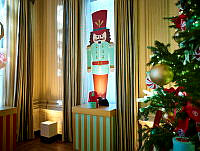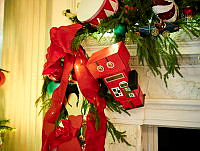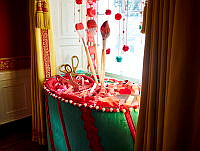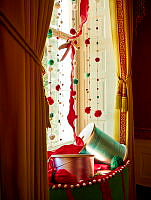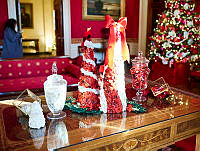Rubenstein Center Scholarship
The Dolley Madison House on Lafayette Square

The house in which Dolley Madison lived during her retirement still survives on Lafayette Square.
White House Historical AssociationThe Dolley Madison House, a yellow structure on the corner of H Street and Madison Place in “The President’s Neighborhood” surrounding Lafayette Square near the White House, was built in 1818-1819 by Richard Cutts, a congressman from Massachusetts who was married to Dolley Madison’s sister Anna. The mortgage passed to President James Madison, and, after his death, to his wife, who lived there off and on until she died in 1849.
As a celebrated former first lady, Dolley Madison was accorded much respect in the capital city, and her residence became the center of a bustling social scene. Journalist and editor Anne Royall visited her and later wrote: “No wonder she was the idol of Washington—at once in possession of everything that could ennoble a woman. But chiefly, she captivated by her artless, though warm, affability. . . . Her power to please—the irresistible grace of her every movement—sheds such a charm over all she says and does that it is impossible not to admire her.”1

This watercolor portrait of Dolley Madison, painted about 1840 when the former first lady lived on Lafayette Square, is attributed to Mary Estelle Elizabeth Cutts, Dolley Madison’s niece.
White House Collection/White House Historical AssociationIn 1851 Charles Wilkes, a prominent naval officer who had commanded the U.S. Exploring Expedition to the Pacific, 1838-1842, purchased the property and made several renovations. He reoriented the main entrance to H Street, replaced Federal-style windows with large bay windows, and installed an iron porch on the side fronting Lafayette Square.
For several months during the Civil War, the residence was occupied by Major General George B. McClellan. There President Abraham Lincoln met with him to discuss strategy—when McClellan made time to see him. Julia Taft Bayne, whose brothers played with the Lincoln boys, Willie and Tad, recalled that when McClellan once returned to the Dolley Madison House and was told by his orderly, “The president is in the parlor waiting for you, general,” McClellan responded by heading upstairs and laying down on his bed. “The president waited a while longer,” Bayne continued, “Then he said, ‘Come, boys, let us go home.’ And they went.” After McClellan also made Secretary of War Edwin M. Stanton cool his heels when Stanton stopped by for an urgent meeting, the secretary of war raged, “That will be the last time General McClellan will give either myself or the President the waiting snub!”2

Dolley Madison House, c. 1918-1920, with the bay window facing H Street added by the Cosmos Club.
Library of CongressIn 1886 the Cosmos Club purchased the residence and made many alterations. The central doorway facing H Street was converted into a large bay window, and the interior featured a reading room, parlor, assembly room, billiard room, card room and chess rooms. The club celebrated the wide-ranging renovation with a formal reception for about 700 invited guests in February 1894. In 1940 the federal government purchased the residence from the club for $1 million to use for expanded Treasury Department agencies but leased it back to the Cosmos Club for the next 12 years because no money was available for new construction on the site.3
After the club finally relocated to Massachusetts Avenue in 1952, the Dolley Madison House was used for government offices, including the National Aeronautics and Space Administration. It was in the house’s ballroom in April 1959 that the first seven Mercury astronauts were presented to the press; NASA information director Walter Bonney made the introductions: “These are our astronaut volunteers. Take your pictures as you will, gentlemen.” Astronaut Wally Schirra called it “a scary event, as we faced a thundering herd of reporters and photographers.”4

Entrance to NASA headquarters at the Dolley Madison House, c. 1958-1961.
National Aeronautics and Space Administration, NASA History DivisionPlans to raze the Dolley Madison House and other nearby historic structures in the Madison Place and H Street area for a new $6.3 million U.S. Court of Claims building, invited concern, and in August 1957 and March 1960 Sen. James E. Murray of Montana proposed legislation to designate all of Lafayette Square as a national historic site. On April 11, 1960 two U.S. Representatives—Frank Thompson, Jr. of New Jersey and Harris B. McDowell, Jr. of Delaware—termed plans to demolish the residence “an act of supreme folly” and called on the General Services Administration to explore alternative sites for the new U.S. Court of Claims Building.5
The house became a focal point of First Lady Jacqueline Kennedy’s preservation efforts for Lafayette Square during the 1960s when she asked architect John Carl Warnecke to develop plans for preserving the Dolley Madison House and other historic buildings in the area. Today the Dolley Madison House quarters part of the United States Court of Appeals for the Federal Circuit.




















































